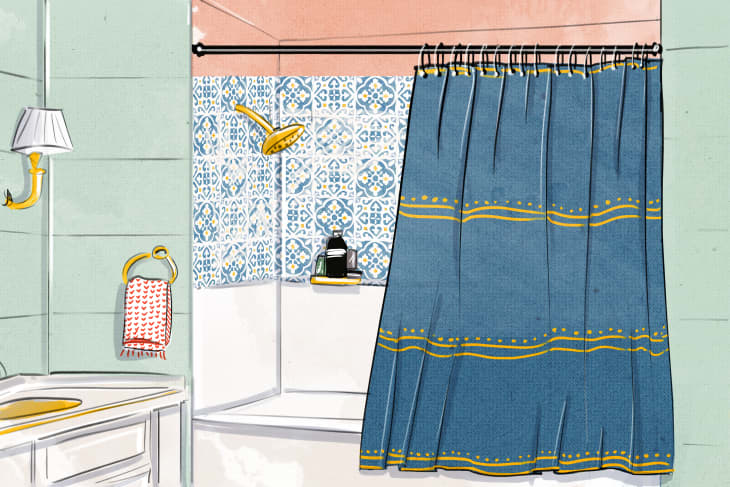Removing Old, Bulky Shower Doors Is Much Easier Than You Think

If you’ve ever wanted to get rid of your old shower doors and replace them with a curtain, it’s much easier to do than you think. There are many good reasons to switch them out: some are leaky or collect mold. They also get in the way of cleaning and bathing kiddos.
A curtain eliminates all of these things and can be thrown in the wash when it gets too dirty. Plus, when the curtain is left open when not in use, the bathroom feels so much larger than before. Don’t be daunted by the idea of leaving holes in the walls —you’ll be happy you took the plunge!
What You Need to Remove a Shower Door
Materials
- Caulk remover (I used Motsenbockers Lift Off gel)
- Curtain rod
- Shower curtain (a liner at minimum, plus outer decorative curtain if you like)
- Shower curtain hooks
- Silicone caulk
Tools
- Utility knife
- Screwdriver
- Plastic scraper or an old credit card
- Caulk gun
Instructions for Removing a Shower Door
1. Remove Shower Doors From the Track
Mine lifted up and out from a top track. The doors can be heavy, so get help on this part if you need it.
2. Remove Screws From the Shower Door Frame
My frame had three screws on each side and zero in the bottom track (jackpot!). There actually was one small screw in the bottom track that was the reason I put off removing the doors for so long (in fear of leaving a hole in the bathtub), but it turned out to just be a set screw for the guide on the track.
So, if that’s holding you back, do a little investigative work to determine whether the screw actually penetrates the tub body.
3. Carefully Cut Any Caulked Joints
Use your utility knife to break the seal between the frame and the walls and tub. Be sure to hold the knife parallel to the wall and tub, not perpendicular. You don’t want to leave cuts in the wall and tub surfaces, you just want to separate the frame from the wall.
4. Pop Off the Top Track
Mine was not attached to the rest of the frame at all, it was only sitting in place on top of the side frames. A simple jolt with the palm of my hand loosened it, and it lifted out easily.
5. Remove the Side Frames
Have your utility knife handy in case you need to cut a little more caulk as you pull the frames from the walls. There will be caulk left behind on the tile, but don’t worry.
6. Remove Bottom Rail from the Tub.
Prepare yourself – this is going to be yucky! But this moment is also liberating, seeing your tub free of cumbersome metal frames. Think of it as having braces removed!
7. Scrape Up Excess Caulk
This is where an old credit card can come in handy – I found it most effective in scraping up the discolored caulking left behind once the door frames were removed. You likely won’t get all of the caulk removed in this step, but that’s okay! Just get as much as you can without damaging any surfaces.
8. Use Caulk Remover on Stubborn Spots
I applied a gel to the strips stuck on the tub, let it sit a few minutes, then scraped again with the plastic card. As a side note, I skipped this step on the wall tiles, as my tiles are unfortunately painted. So, the caulk peeled right off of my walls, along with strips of paint, revealing pink tiles beneath the paint.
Because of this, I left strips of caulk on the walls in some places, as I plan to replace the tile down the road. In the meantime, I will likely peel off the rest of caulk and touch up the tile paint, but this wasn’t done as a part of this project.
Also, our tub surface beneath the old track is pretty rough, but any discoloration came off with this step. There are still pocks in the surface, but I far prefer them to the constantly-dirty old shower door frame!
9. Fill the screw holes in the walls
This can be done in a few ways: with special plugs inserted into the holes or with silicone caulk matching your tile. I chose the latter and filled the holes with white silicone caulk. This is where the old credit card comes in handy again.
Fill the holes with silicone caulk, then remove excess with that nifty card! Allow the caulk to set for 8 hours before exposing to moisture. If the holes have plastic anchors in them (mine did), just pull them out with a pair of needle-nosed pliers before filling them.
10. Hang that glorious new rod and curtain!
Helpful hint: Attach curtain hangers to the curtains before stringing them onto the rod. This way, you aren’t tottering up on the edge of the tub, wrestling twelve grommets onto clips.